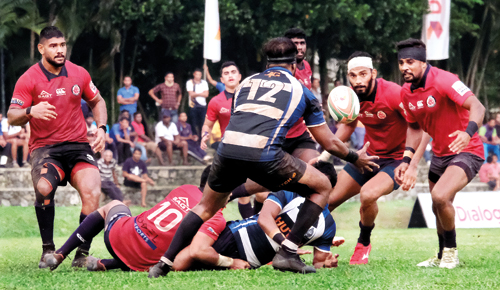‘Always breakdown’ – the high penalty count
View(s):
The Dialog Rugby League has had mixed fortunes so far - File pic by Amila Gamage
The breakdown is an important part of rugby but should not be confused with the breakdown of expectations. The anticipation of upping the competition by including a foreigner in the last four teams of last year’s league is now at a standstill.
With a stay order one may not see the foreigners balancing the competition in the near future. That is not the breakdown we are talking of being an important part of rugby. It is rugby during the period of play just after the tackle and before and during the ruck and a focal point of competition for the ball. This is an explosive form of contest in the game with anything from 180 to 200 in international games. This is an area that adds value or mars the game flow. Look at the penalty count of Sri Lanka Rugby.
The breakdown, today, involves all players and is no longer a place where the forwards dominate. In the first three weeks of the SLR league; penalties have ranged from a low of 16 to a high of 32 in a match. Yellow cards have reached a high of 6/7.
Out` of the penalties conceded there are between 60 to 70 % at the tackle, ruck and maul whatever the numbers. That is those are that have been penalised right or wrong while there are scores that are missed and not penalised. The higher percentage of penalties at the TRM is not limited to Sri Lanka but is around 50% at the top end of rugby. It has an effect on the game. The low of 16 penalties included 12 (75%) at the TRM.
All players are responsible and should be able to play at the breakdown .The ball carrier has a job to win the contest at the contact, and secure the ball. The carrier can be any player and often it may be the backs and underscores their responsibility at the break down.
Often we see the ball carrier being penalised for not releasing .The law allows for the player carrying the ball to have a go twice with the ball. The first is the fight in contact, and the second is the fight on the ground. The player can twist to an advantageous position and control the ball on the ground. This second go allows the player to use this opportunity to change body position and get the ball as far away from the opposition as possible. How well is this done and how well is it policed is what has to looked at as this slows down the game and also attracts the whistle.
Most times the ball carrier is penalised for holding on or for the mistakes or twisting and not making the ball available for play. On the other hand the question that is raised by coaches and sometimes eager broadcasters is to whether in policing; that the whistle was blown too early. This can be easily sorted out for better rugby through communication and relationship between coaches and referees so much so that that all understand the expectation of each other for the game. Talking to people that matter I feel there is a life of living in two compartments while neither party wants to visit the other.
The first supporting player has the responsibility to either win the space over the ball or to eliminate the threat of a player from the defending team coming through the tackle area. The first supporting player is the primary decision maker at the ensuing ruck. They can choose to “take the space” above the ball. This act is designed to secure possession and also mark the offside line.
The second supporting player who reaches the breakdown or a ruck if formed has the option to either support or clean out or to play the ball immediately by passing.
The third supporting player into the ruck must come in consciously straight and with the option to either support and drive over the ball or to shift the ball out immediately by playing it from the base of the ruck.
The first defensive players at a tackle situation come to challenge the breakdown or to establish a position on the defensive line. Getting this decision right is important to achieve success on defense. It is here that penalties are given as space is blocked in front of the hind most foot or not binding properly .
The player who gets to the tackle and has the right to the ball must be allowed until a ruck is formed, Sometimes a thin line and a matter of time, this has to be policed and played properly for a better game.
If the defending team gets this wrong even 10% of the time, and there are 180 breakdowns there will be 18 penalties. Making the right decision is a very challenging proposition for players as well as referees.
 As a defender you apply pressure at the breakdown to force the attacking team to commit numbers to the breakdown with the goal of putting pressure to slow down the speed of the breakdown. The intention of slowing down if not done properly is where you don’t stay on feet and or don’t enter correct etc.
As a defender you apply pressure at the breakdown to force the attacking team to commit numbers to the breakdown with the goal of putting pressure to slow down the speed of the breakdown. The intention of slowing down if not done properly is where you don’t stay on feet and or don’t enter correct etc.
If the defense attempt to win possession at the breakdown they need to be fast an. get down, get low and get your hands on the ball early. This is a high-risk, high-reward strategy that can attract the whistle.
The majority of theses penalties come because the player uses their hands after a ruck is formed. That is when you don’t shift form hands to ball and winning possession to slowing the attack’s ball down. That makes the difference.
To improve the game and let it flow this is an important area that has to see the blessing of both coaches and referee. All have to help each other and improve the important areas than pointing on the commas and full stops.
England considered as genuine World Cup challengers, seemed ordinary after they were comprehensively outplayed by Ireland and, after two less convincing displays against Wales. In these games they displayed problems at the break down. Did they recover in their game with the wallabies and are they back on their feet?
Vimal Perera is a former Rugby Referee, Coach and a
former Accredited Referee’s Evaluator for IRB


